You’re a beginner in farming, and you need some information about what kind of food you should give the chickens on your farm. Scroll down for more information!
Okay, so you got it all figured out – nesting boxes, roosting bars, even the feeders. But you are not yet sure what to put in them.
What Can Chickens Eat? Luckily, chickens are omnivores which means that they can eat lots of different food – from meat to vegetables.
Continue reading this article, and you will discover a detailed list of some of the healthiest food choices and some ingredients that you shouldn’t give your chickens if you don’t want any problems with the farming business.
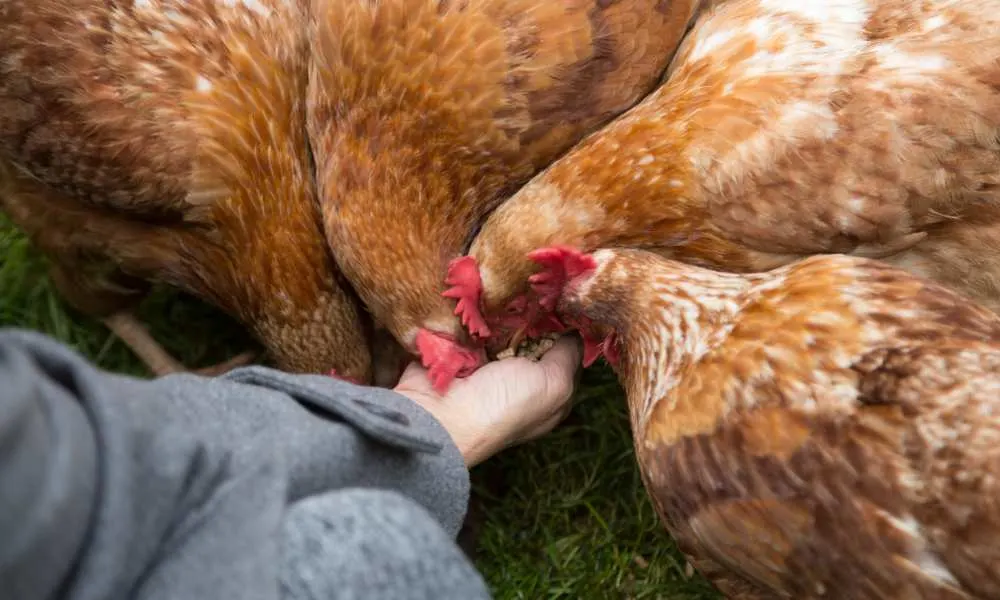
What Can Chickens Eat?
Chicken feed is a packaged type of food that chickens consume daily. It usually consists of different ingredients such as grains and oilseed beans that are rich in protein. This food makes up 70% of your chickens’ diet, and by consuming it regularly, they maintain a healthy diet.
From a farmer’s point of view, he should search for quality ones when shopping for chicken grain or corn feed. Why?
Because chickens can be sensitive to specific ingredients, such as minerals and amino acids, for example. The imbalance in vitamin content can disrupt your chickens’ diet plan very easily.
The most popular chicken feed brands are:
- F.M. Browns
- Hilland Naturals
- Manna Pro
- Prairie’s Choice
If you want to make the right choice and provide your chickens with good-quality food that will satisfy their needs, opt for one of these top 7 chicken feed choices:
| NAME | WHY IT IS GOOD |
|---|---|
| “Prairie’s Choice Non-GMO Backyard Chicken Feed” | Made from non-GMO ground corn, contains A, B-13, D vitamins, rich in proteins and fiber, comes in 25 lbs packages |
| “Coyote Creek Certified Organic Feed” | Good for baby chickens and egg-layers, 100% organic and non-GMO, contains organic soybeans |
| “Kalmbach Feeds” | Contains calcium that help egg-layers, comes in 40-50 lbs packages, contains a large variety of supplements |
| “Scratch and Peck Feeds” | Contains organic wheat and barley, 100% corn and soy-free easily digestible |
| “Brown’s Layer Booster Chicken Feed” | Contains soybeans and wheat, includes vitamin E, A and D-13, high in proteins |
| “Small Pet Select Chicken Layer Feed” | Non-GMO contains omega-3 vegetable oils, comes in 25 lbs package |
| “Manna Pro Organic Grower Crumbles” | Contains omega-3 maker supplements, non-GMOcomes in 10 and 30 lbs packages |
These were just some of the choices that you can choose from when shopping. The market for forage is enormous, and you can become tempted by all the possibilities.
However, there are some things that MUST be on your chicken feed list, no matter the brand you chose.
ALWAYS LOOK FOR:
- PROTEINS: necessary for maintaining energy levels
- VITAMINS: must contain A, E, D, or B-13 vitamins
- ENZYMES: makes the food easily digestible
- FATS: important for basic cell function and maintenance of body-fat
- CARBOHYDRATES: energy source
Okay, so we said that chicken feed is the most common, but not the only food these animals can consume. They are omnivores, and they would love to peck on some other nutrients as well.
So, what can your chicken peck on other than the basic chicken feed?
Supplements can be very beneficial for your chickens’ diet. Therefore, try adding:
- Oyster shells
- Scratch
- Poultry grit
- Sprouted bales of straw
- Bird feed
- Sprouted grains
Learn More: Can Chickens Eat Bird Seeds?
You are well aware that bugs are a great source of protein, and your chicks would love some:
One bug that can be detrimental to their health is a fly. Although they have a habit of catching and eating flies, like many other animals, they shouldn’t do this.
Chickens can also consume slightly larger insects like:
Although they can use these animals as food, it doesn’t mean that they shouldn’t. The best advice would be to keep your chickens as far away from rodents as possible. Sometimes, roles can swap, and your chicken can become food.

What about grass and flowers? If you’ve been to the countryside, you must have seen dozens of chickens released into the yard and pecking at the grass.
This is actually really good for your chickens because they can take in a lot of vitamins through:
If you are a little short of feed supplies, it’s winter, and you can take your chickens out – don’t worry. These animals would love some ingredients from your kitchen.
Prepare yourself, it’s a long one.
- Almonds – contains ⅛ of a person’s daily protein need
- Apple peels – do not feed this to your chickens with seeds, remove all of them
- Asparagus – rich in antioxidants and potassium
- Bananas – contains vitamin C
- Baked potatoes
- Bean sprouts
- Bread
- Broccoli
- Cabbage – a great source of healthy minerals and vitamins
- Cheese – the only dairy product they can digest well
- Chia seeds
- Rice – only cooked rice
- Corn – cracked corn is the most popular chicken feed
- Cucumbers
- Grapes
- Oranges (peels)
- Peaches (peels)
- Popcorn – rich in vitamin A, E, and K
- Pumpkin
- Quinoa seeds
- Spinach
- Shrimp – only if it’s properly cooked
- Sunflower seeds – second most popular chicken feed
- Tomatoes – high in vitamin C, B9, and protein
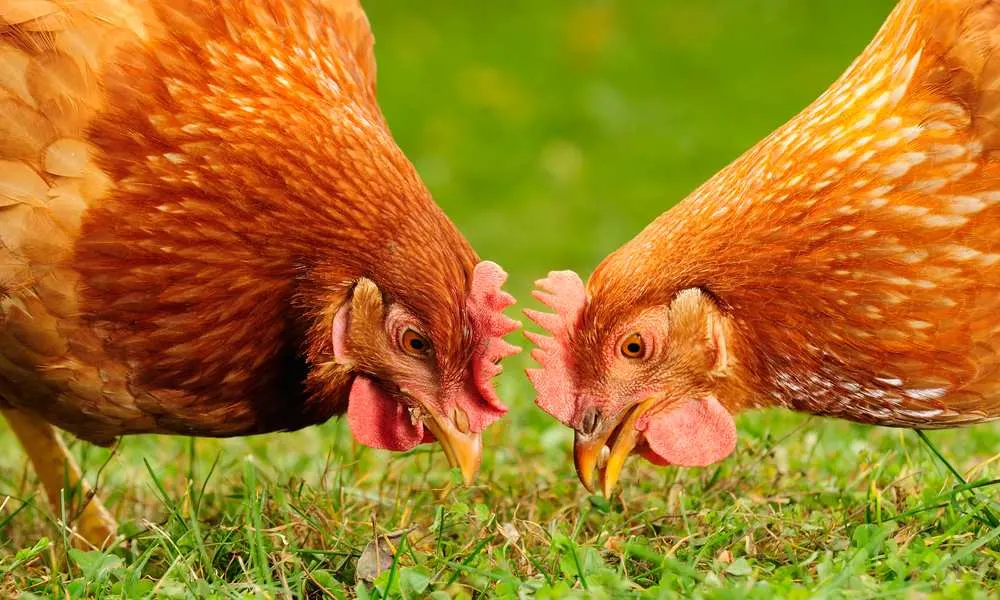
Basically, any peeled fruit or vegetable is a great treat for your chickens.
We have listed all the ingredients that you SHOULD give to your chickens as food, but we haven’t mentioned the ones that shouldn’t find their place near chicken feeders.
Let’s take a second to list down what food you should AVOID.
As we mentioned earlier, chickens can be pretty sensitive to some ingredients like minerals and amino acids. So, when preparing to feed your chicks, you should exclude certain items.
For example, if we focus on outdoor nourishment and ingredients found in the garden, be on the watch for:
- Green potatoes
- Tomato leaves
- Onions
- Rhubarb leaves (See Also: Can Chickens Eat Rhubarb?)
Of course, some treats from the kitchen that are delicious to you are TOXIC for your chicken. Here is a shortlist of them:
- Caffeine
- Alcohol
- Anything with an excessive amount of salt
- Avocado
- Butter
- Candy
- Fried food
- Snacks like chips and pretzels
- Rotten or moldy food
- Soda and other fizzy drinks
- Undercooked food
You might be wondering why rotten or moldy food stands out from the list?
Simple, people have this misconception that anything that has stayed for too long in their kitchen should be given to their animals as food. This is a big mistake. Just like people shouldn’t consume rotten meat or vegetables, it doesn’t mean that animals have the ability to digest them.
If you have some rotten or undercooked food in your kitchen, don’t give it to your farm animals – throw it away in the garbage. You are risking poisoning your animals.
All of these foods from the list above are extremely toxic to your chicks and can very easily lead to poisoning or heart failure.
Here is a short video summing up your chickens’ Dos and Don’ts.
Chicken Diet – A Close Up
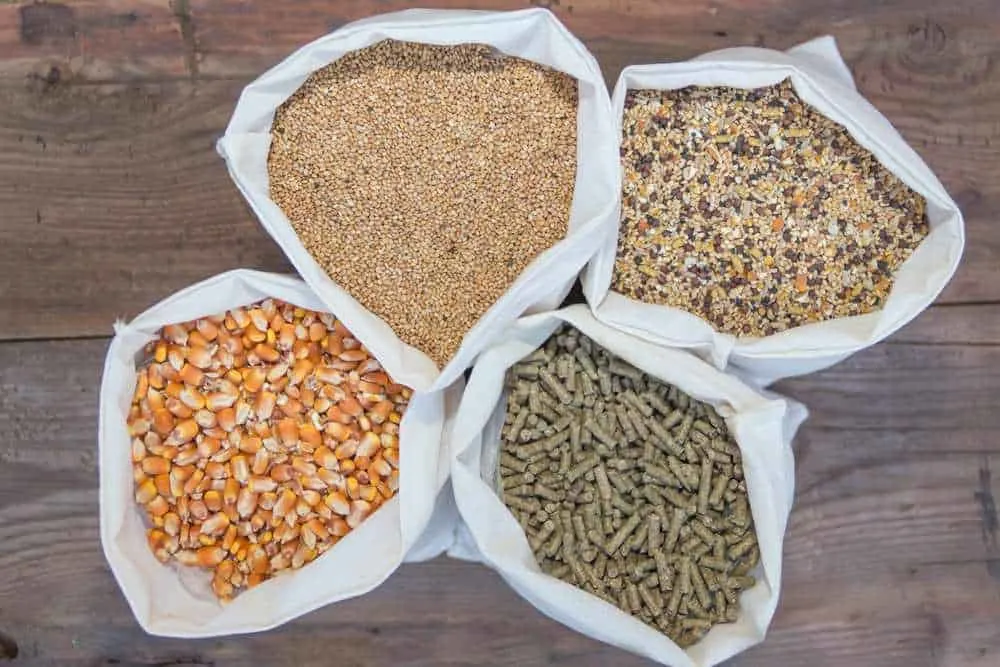
As your chickens grow and change, so does their diet plan. Here is a brief overview of what and when to feed your chickens.
| 1 – 8 week chicks | The food that you should start off with are crumbles. Also, start introducing grizzard for better digestion. |
| 8 – 18 week chickens | During this time, you should feed your chickens grains. Choose food that contains 16-18% of proteins. |
| 18 + weeks chickens | After they pass 18 weeks, you can switch to layer feed.This is great for hens that are supposed to lay eggs. |
Important note: There are a couple of types of commercial chicken feed that you can buy.
- Chick starter: This is the type of food you give to your baby chicks (obviously). The best choice for you would be to go for an organic one.
- Grower pullet: You can switch from chick starter to growing pullet when your chicks grow up and pass eight weeks. These types of food are usually high in protein – about 18%.
- Pullet developer or finisher: After your chickens passed 14 weeks, it’s time to switch to pullet developer or finisher – depending on their overall development and appetite.
- Layer rations: This is the go-to type of food for your hens that are in the process of laying eggs – mainly because they need a lot of protein intake.
- Broiler rations: If you are going to slaughter your chickens, this is the food you should give them. It will significantly contribute to their body mass.

Chickens Eating Chickens?
Oddly enough, it is possible. Chickens CAN eat chicken meat, but they can eat other chickens as well. Let’s try to explain.
According to animal experts and nutritionists, there is nothing wrong if you feed your chickens cooked chicken meat – they will gladly eat it.
Chickens generally thrive off meat-based food, and chicken meat happens to be one of the healthiest choices. If properly cooked, you can expect your hens to peck at some leftovers – however strange that may sound.
Chicken cannibalism is not unusual if your chickens have been cut off from food resources for a long time. What does this mean?
It simply means that there may be some chaos in the chicken coop if your chickens are starving. At a certain point, they will be tempted to eat another – alive or dead.
To show you that this is a fact, here is a video proving it:
When it comes to chicken-based nutrients, you should NEVER FEED YOUR CHICKEN:
- Raw chicken food
- Fried chicken food
- Rotten chicken food
All of these are high in salt and can be toxic to your chicken.
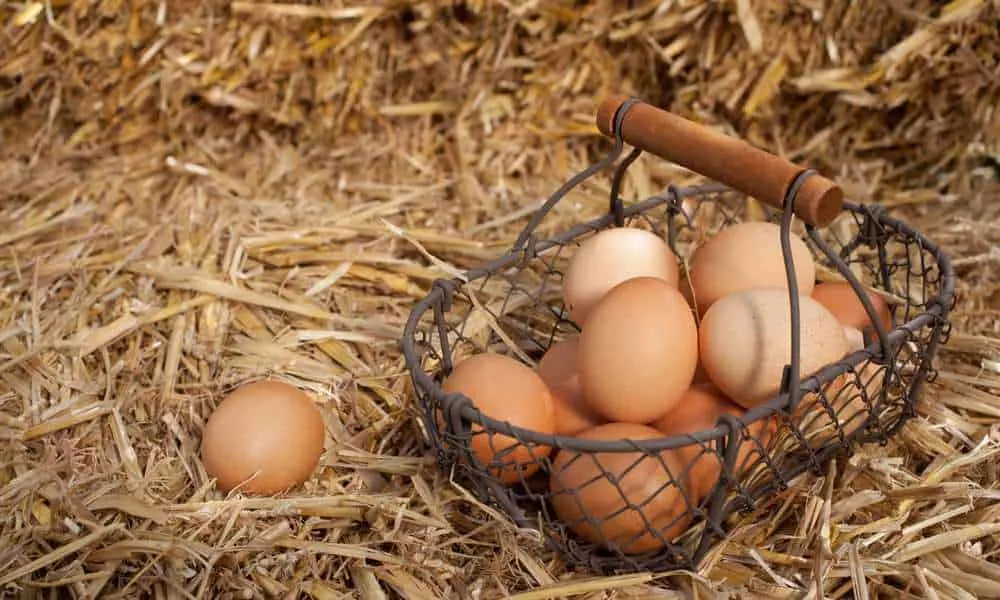
The Egg Hunt
Watch out for your chicken eggs! It’s not like in cartoons – wild animals sneaking in and stealing freshly hatched eggs. This is reality, and you need to watch out for chicken predators.
Yes, that’s right. Chickens will sometimes eat their eggs.
If you’re a farmer who is making money by selling them, you need to put a stop to this ASAP. But how do you do that?
You need to be on EGG-WATCH.
You can prevent the chickens from eating their eggs by lowering the breakage possibility. How?
- 12-inch square nests for 4-5 hens
- Boxes should be at least 2 feet from the ground
- 2 inches of clean nesting material in the nest at all times
- Never forget to feed your chickens!
- Collect eggs early in the morning (before 10 a.m)
Apart from these nesting hacks, you can also try:
- Avoid strong lighting near the nesting boxes.
- Not disturbing the hens while they are sleeping.
- Setting up a second feeding station away from the eggs.
- Let your hens outside while you collect the eggs from the nesting boxes.
If you are dealing with hens that are entirely out of control and can’t stop eating their eggs, you can turn to some basic tricks.
You can swap the actual eggs with golf balls. The hens will soon grow tired of pecking the golf balls and not being able to eat them.
Search online for “roll-away nesting boxes.” These are very practical and helpful. As soon as your hen lays the egg, it will fall in the roll-away box and go straight to you. Great, right?
Some people used to fill the hatched eggshells with mustards – chickens hate this. They will think it’s a real egg and go after it. However, this should not be your go-to hack.

Chickens And Dogs Sharing Food – Yes Or No?
Chickens don’t choose much when it comes to food. They can eat anything and everything. But that doesn’t mean you shouldn’t pay attention to their food choices.
For example, let’s say you have a dog o and a couple of chickens in your backyard at the moment. The dog food also happens to be there in a bowl next to the dog house. At one point, you notice that both the chicken and the dog start eating the dog food from the bowl.
Is this normal, or should you be worried?
Fortunately, your chicken’s diet will not be harmed if it eats food that was intended for your dog. Of course, this applies to quality purchased food.
You shouldn’t put all of your worries to rest. In some cases, the dog food that your chicken ate might not turn out to be such a good idea.
If your chicken happened to eat some poor-quality dog food, you should watch out for some red flags, and here is what exactly:
- Insufficient egg production: your chickens might start producing eggs at a slower rate.
- Uneasiness: your chickens might start acting nervous most of the time.
- The strange shape of the eggs: your chickens might start producing eggs that are either too big, too small, or just too squishy.
Although chickens eating dog food doesn’t necessarily translate into a bad diet, you should stick with the old-fashioned way of feeding your chicken – with their own food.

Save Some Money On Chicken Food
Regularly buying food for any livestock can empty your pockets more than you hoped for. Animals should not be left without food, but you can do something about it.
There are numerous ways in which you can save money and still feed your chickens.
Here are a couple of solutions:
1. Look Around And Shop Smart
If you want to find some affordable but good-quality chicken feed, you need to visit different shops. You might be missing out on some really cheap but good feed just because the shop is a little further from your house.
2. Make Your Own Chicken Feed
The most common way to save money on livestock food is to make your own. Fortunately, today there are many sites online that can teach you how to make healthy homemade feed for your chickens – all natural!
3. Buy Chicken Feed In Bulk
Often, the seller will give you a good discount if you choose to buy a larger quantity of chicken feed. This way, you will save your money and have more for your chickens. If you don’t need that much feed, you can split it in half with your friend – smart business.
4. Ask For Leftovers At A Grocery Store
There is absolutely no shame in going to your local grocery store and asking for some leftover vegetables or fruits. This might not mean anything to the store owners, but it can help you and your chickens a lot.
5. Grow Your Own Feed
If you have some extra space in your backyard, you can always start to grow your own: sunflowers, crops, greens, etc. This will not only help your chickens, but it can be of use for you too.

Homemade Recipe – Quick & Easy
We mentioned that you could make your own chicken feed if you want to save some money. Making your homemade recipe can be quick and easy. All you need is:
| INGREDIENTS |
|---|
| 5 pounds of dried split peas |
| 3 pounds of white wheat |
| 3 pounds of cracked corn |
| 1 pound of dried grubs |
| 2 pounds of barley |
| 2 pounds of rolled oats |
| 1 pound of pellets |
| 1.5 pounds of sunflower seeds |
| 1.4 pound of sea kelp |
| 1.4 pound of brewer yeast |
After you’ve got all this under your nose, mix it up in a large barrel, leave it to stay for 2-3 days and you can serve it to your chickens.
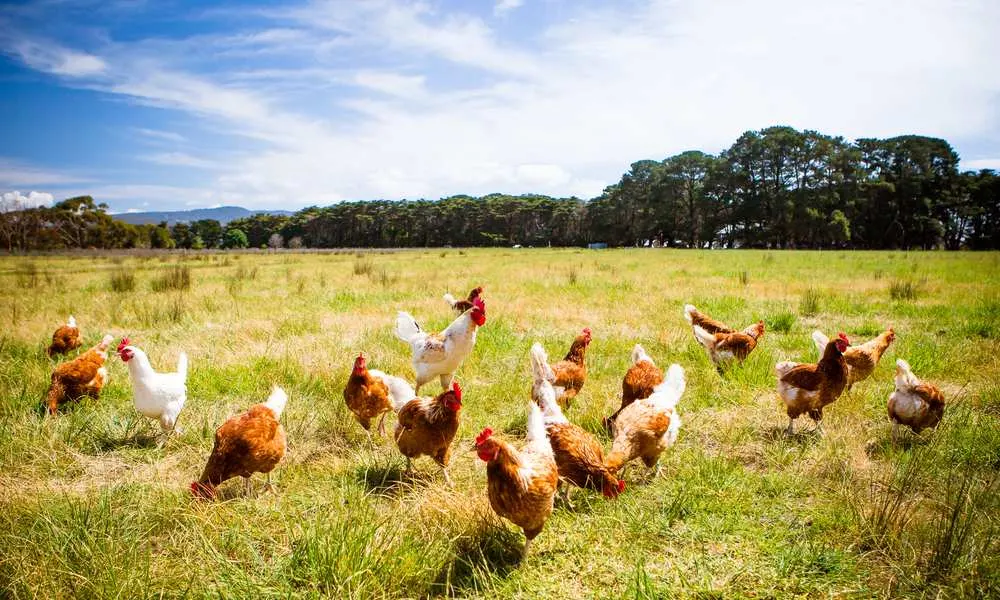
The Poultry Popularity
The popularity of poultry farming has significantly risen in the last couple of years. There are different types of poultry farming, and chickens hold the first place.
The market for chicken meat has expanded enormously and today it counts 13.8 million tons in one year.
China, America, and Brazil are the world’s most famous exporters of eggs. Take a look at the numbers supporting that:


Nesting Boxes – Tips
Preparing feed for your chickens is very important, but you need to make them feel comfortable. Yes – it’s about the nesting boxes. The condition and environment in which chickens spend their time can affect their diet, health, and overall behavior.
If they are well “accommodated,” they will regularly eat, sleep and lay good eggs – this is what you’re aiming right, yes?
Here are some tips on how to keep your chickens’ nesting boxes in good shape and safe:
| Have Enough Boxes: | Overcrowding can be a massive problem if you are keeping an entire farm of chickens. If there are too many of them, they can feel uncomfy, and egg-laying can be slowed down. Therefore, before you start raising chickens, make sure you have enough for all of them. The ideal number would be 4-5 chickens per one box. That way, they will all have space to lay their eggs without difficulty. |
| Nest Egg Training: | We mentioned golf balls earlier as preventing chickens from eating their own eggs. However, they have another function. Before your hen starts to lay eggs, you need to take a couple of golf balls and put them in the nesting boxes. After you do so, they will understand that this is where they should lay their eggs. Please have patience. The first laying of eggs may not be so successful, so you will have to look for them in the yard. |
| Early-morning Visits: | When it comes to collecting coca eggs, it can be difficult. Chickens are very sensitive animals and can very quickly get upset at the slightest sound. So, it is up to you to avoid this by making a habit of early morning visits. Yes, try to visit your hens before the rooster announces the start of a new morning. |
| Keeping The Nesting Boxes Clean: | One of the most important things about nesting boxes is that they’re completely clean. When it comes to the environment in which your hens lay eggs, you can’t be lazy and avoid cleaning. It is recommended to visit the nesting boxes once a week and clean them all. Only in this way will you surely get healthy eggs. |
Conclusion
As you can see, chickens are very interesting animals when it comes to their diet. And if they have a wide selection of foods that they can choose from, attention must be paid – especially when it comes to certain ingredients. Keep your hens and roosters safe by providing them with a fine choice of feed.

